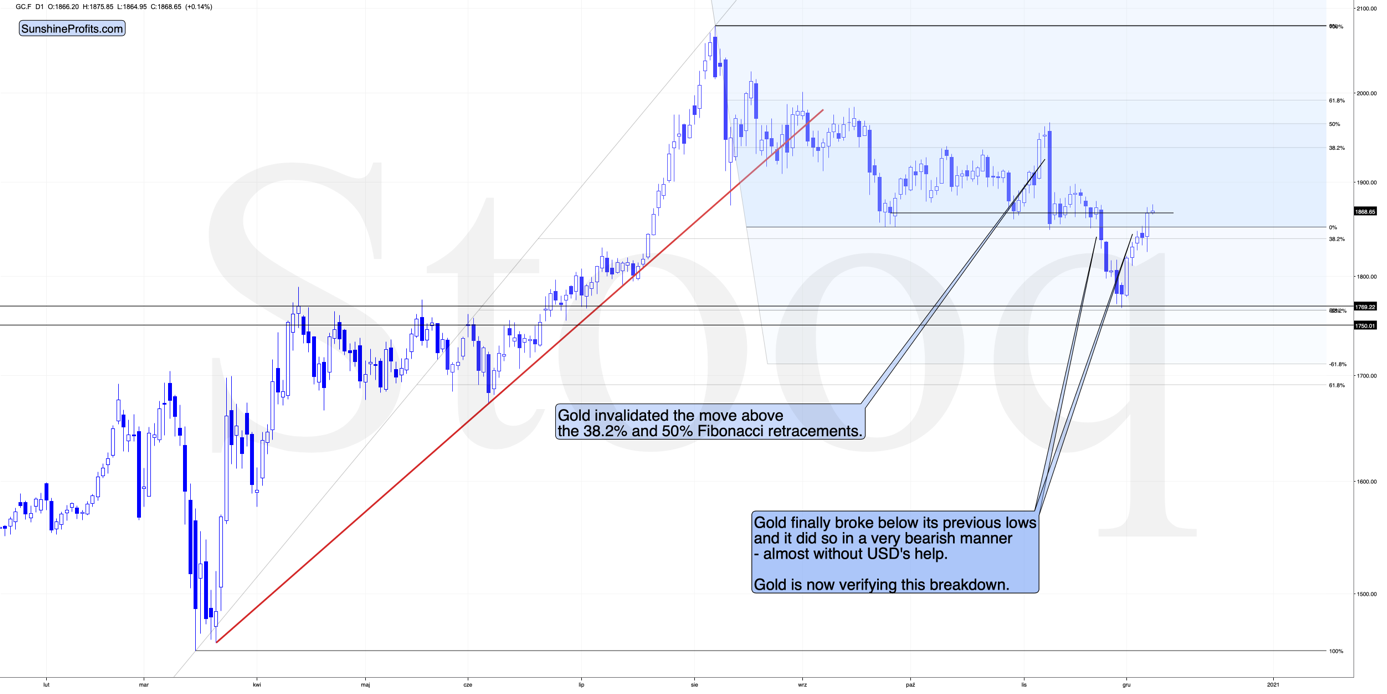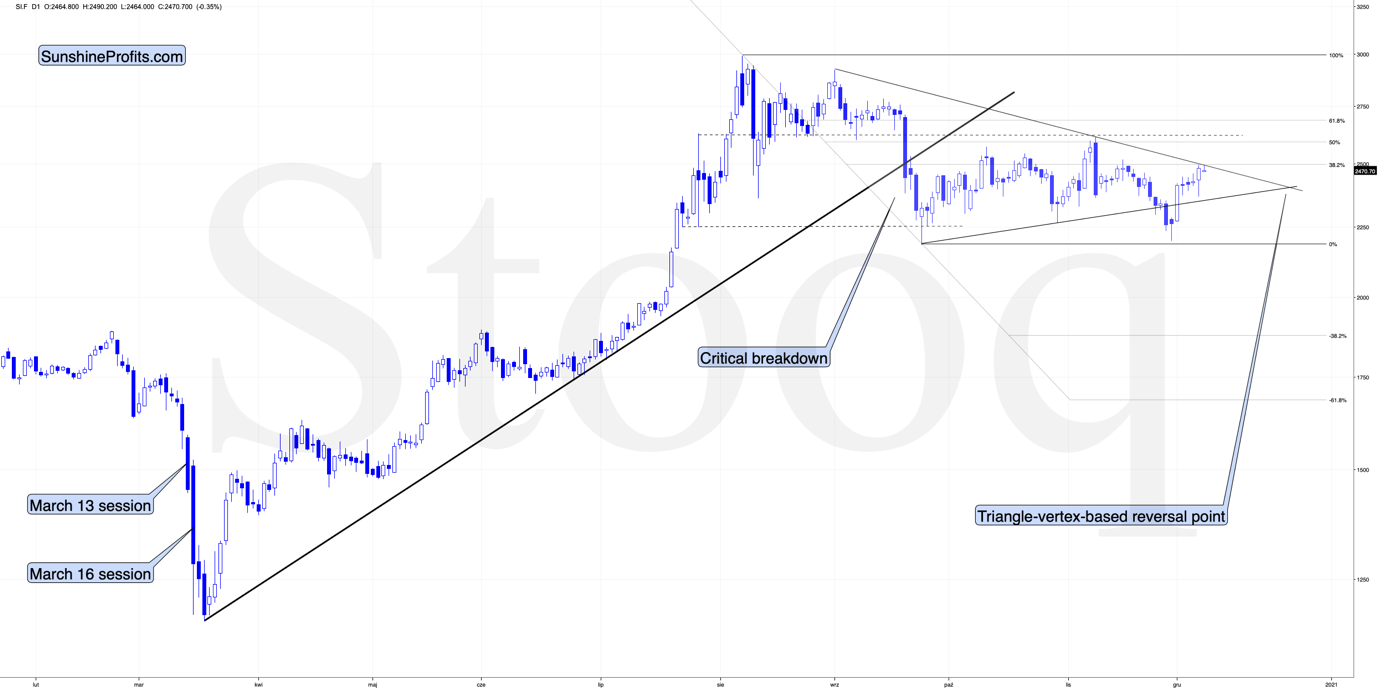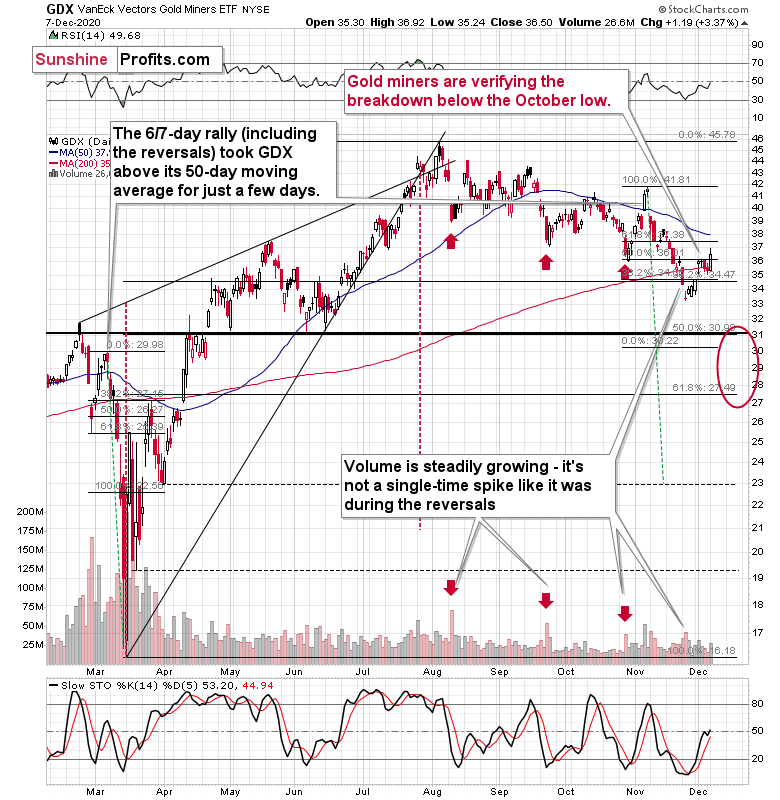Briefly: in our opinion, full (300% of the regular position size) speculative short positions in mining stocks are justified from the risk/reward point of view at the moment of publishing this Alert.
The entire precious metals sector moved higher yesterday, and one might wonder if this changes anything regarding the outlook. In short, it doesn’t. The move higher was in line with what I previously described as a likely outcome.
It was quite possible for gold to rally up to its September lows, and the low in gold futures in terms of the closing prices was $1,866.30. Yesterday’s closing price for gold futures was exactly $1,866.
So, did anything unusual happen? Not really.
But can gold move even higher from here? As discouraging (or encouraging, depending on one’s perspective) as this answer may be, it’s a “yes”. The US Dollar Index is currently trading at about 90.8, and its downside target is at about 90, so there is room for another short-term slide. Such a slide would be likely to trigger a rally in the yellow metal. How high could the rally go during this final part of the counter-trend corrective upswing?
Perhaps to the mid-November high of about $1,900. Even though gold might theoretically rally all the way up to the early-November high, I don’t see this as being likely.
At the moment of writing these words, gold has corrected more or less half of its November decline. Did silver correct as much?
Actually, silver corrected visibly more. Its already at its mid-November highs and relatively close to its early-November top. This means two things:
- If gold rallies to its mid-November high, silver could rally to its early-November high – to about $26.
- Silver is definitely outperforming gold , which is something that we tend to see before sizable declines – that’s one of the key silver and gold trading tips .
Moreover, please note that silver has a triangle-vertex-based reversal point in the final part of the month, which could imply that this is where silver forms a final, or temporary bottom. This could have implications also for the rest of the precious metals sector, as its parts tend to move together in the short and medium term.
Given the bearish post-Thanksgiving seasonality in the case of PMs and the tendency for them to form local bottoms in the middle or second half of December, it seems likely that the above is likely to be some kind of bottom.
Let’s get back to issue of the relative performance. While silver tends to show strength relative to gold before bigger declines, gold stocks tend to be relatively weak. Are they?
Of course they are! Even taking into account yesterday’s quite visible upswing, gold miners have clearly not corrected half of their November decline.
Miners are not even close to their mid-November highs, let alone the early-November highs.
So, yes, miners did move higher yesterday, but examining their recent rebound and comparing it to what happened in gold and – especially – silver, provides us with very bearish implications.
What we see in the PMs is just a correction, not the start of a new, powerful upleg. If it was, miners would have been leading the way higher. We currently see the opposite.
Over a week ago, I wrote that miners could move to the previous lows and by moving to them, they could verify them as resistance. The previous – October – low is at $36.01 in intraday terms and at $36.52 in terms of the daily closing prices. Yesterday, miners closed at $36.50.
So, while gold closed at its September low (in terms of the daily closing prices), gold miners closed at their October low.
If the USD Index declines one more time before bottoming, and gold rallies, miners could also mover temporarily higher. How high could they move? I think that the mid-November high of about $38 (intraday high: $38.35, daily close: $38.01) would provide the kind of strong resistance that miners might not be able to breach.
Still, this upside is based on two big IFs.
The first “if” is if the USD Index declines to 90 or slightly lower – it’s extremely oversold, and the CoT reports confirm it.
The second “if” is if the precious metals sector really reacts to USD’s decline with a visible rally. In the past few weeks, gold shrugged off quite a few USDX declines. And miners shrugged off even more positive news.
Consequently, it seems that trying to take a profit from the possible, but not very likely, immediate-term upswing is not the best idea from the risk to reward point of view.
Overview of the Upcoming Decline
As far as the current overview of the upcoming decline is concerned, I think it has already begun.
During the final part of the slide (which could end within the next 1-5 weeks or so), I expect silver to decline more than miners. That would align with how the markets initially reacted to the Covid-19 threat.
The impact of all the new rounds of money printing in the U.S. and Europe on the precious metals prices is incredibly positive in the long run, which does not make the short-term decline improbable. Markets can and will get ahead of themselves and decline afterward – sometimes very profoundly – before continuing with their upward climb.
The plan is to exit the current short positions in miners after they decline far and fast, but at the same time, silver drops just “significantly” (we expect this to happen in 0 – 3 weeks). In other words, the decline in silver should be severe, but the decline in the miners should look “ridiculous”. That’s what we did in March when we bought practically right at the bottom. It is a soft, but simultaneously broad instruction, so additional confirmations are necessary.
I expect this confirmation to come from gold, reaching about $1,700 - $1,750. If – at the same time – gold moves to about $1,700 - $1,750 and miners are already after a ridiculously big drop (say, to $31 - $32 in the GDX ETF – or lower), we will probably exit the short positions in the miners and at the same time enter short positions in silver. However, it could also be the case that we’ll wait for a rebound before re-entering short position in silver – it’s too early to say at this time. It’s also possible that we’ll enter very quick long positions between those short positions.
The precious metals market's final bottom is likely to take shape when gold shows significant strength relative to the USD Index. It could take the form of a gold’s rally or a bullish reversal, despite the ongoing USD Index rally.
Summary
Summing up, the next big move lower in the precious metals market is definitely underway and it seems that it will take another 1-5 weeks (likely in the second half of December) before the decline ends. It seems that the part of the slide in gold that takes place below $1,700 is going to see a silver catching up with the decline in gold and miners. Last week’s upswing seems to be a relatively normal bounce within a bigger decline.
Please note that even Warren Buffett is limiting his exposure to gold.
Despite the recent decline in it, it seems that the USD Index is going to move higher in the following months and weeks, causing gold to decline. At some point gold is likely to stop responding to dollar’s bearish indications, and based on the above analysis, it seems that we might expect this to take place in December.
Naturally, everyone's trading is their responsibility. But in our opinion, if there ever was a time to either enter a short position in the miners or increase its size if it was not already sizable, it's now. We made money on the March decline, and on the March rebound, with another massive slide already underway.
After the sell-off (that takes gold to about $1,700 or lower), we expect the precious metals to rally significantly. The final decline might take as little as 1-5 weeks, so it's important to stay alert to any changes.
Most importantly, please stay healthy and safe. We made a lot of money on the March decline and the subsequent rebound (its initial part) price moves (and we'll likely earn much more in the following weeks and months), but you have to be healthy to enjoy the results.
As always, we'll keep you - our subscribers - informed.
To summarize:
Trading capital (supplementary part of the portfolio; our opinion): Full speculative short positions (300% of the full position) in mining stocks is justified from the risk to reward point of view with the following binding exit profit-take price levels:
Senior mining stocks (price levels for the GDX ETF): binding profit-take exit price: $32.02; stop-loss: none (the volatility is too big to justify a SL order in case of this particular trade); binding profit-take level for the DUST ETF: $28.73; stop-loss for the DUST ETF: none (the volatility is too big to justify a SL order in case of this particular trade)
Junior mining stocks (price levels for the GDXJ ETF): binding profit-take exit price: $42.72; stop-loss: none (the volatility is too big to justify a SL order in case of this particular trade); binding profit-take level for the JDST ETF: $21.22; stop-loss for the JDST ETF: none (the volatility is too big to justify a SL order in case of this particular trade)
For-your-information targets (our opinion; we continue to think that mining stocks are the preferred way of taking advantage of the upcoming price move, but if for whatever reason one wants / has to use silver or gold for this trade, we are providing the details anyway. In our view, silver has greater potential than gold does):
Silver futures downside profit-take exit price: unclear at this time - initially, it might be a good idea to exit, when gold moves to $1,703.
Gold futures downside profit-take exit price: $1,703
Long-term capital (core part of the portfolio; our opinion): No positions (in other words: cash
Insurance capital (core part of the portfolio; our opinion): Full position
Whether you already subscribed or not, we encourage you to find out how to make the most of our alerts and read our replies to the most common alert-and-gold-trading-related-questions.
Please note that we describe the situation for the day that the alert is posted in the trading section. In other words, if we are writing about a speculative position, it means that it is up-to-date on the day it was posted. We are also featuring the initial target prices to decide whether keeping a position on a given day is in tune with your approach (some moves are too small for medium-term traders, and some might appear too big for day-traders).
Additionally, you might want to read why our stop-loss orders are usually relatively far from the current price.
Please note that a full position doesn't mean using all of the capital for a given trade. You will find details on our thoughts on gold portfolio structuring in the Key Insights section on our website.
As a reminder - "initial target price" means exactly that - an "initial" one. It's not a price level at which we suggest closing positions. If this becomes the case (like it did in the previous trade), we will refer to these levels as levels of exit orders (exactly as we've done previously). Stop-loss levels, however, are naturally not "initial", but something that, in our opinion, might be entered as an order.
Since it is impossible to synchronize target prices and stop-loss levels for all the ETFs and ETNs with the main markets that we provide these levels for (gold, silver and mining stocks - the GDX ETF), the stop-loss levels and target prices for other ETNs and ETF (among other: UGL, GLL, AGQ, ZSL, NUGT, DUST, JNUG, JDST) are provided as supplementary, and not as "final". This means that if a stop-loss or a target level is reached for any of the "additional instruments" (GLL for instance), but not for the "main instrument" (gold in this case), we will view positions in both gold and GLL as still open and the stop-loss for GLL would have to be moved lower. On the other hand, if gold moves to a stop-loss level but GLL doesn't, then we will view both positions (in gold and GLL) as closed. In other words, since it's not possible to be 100% certain that each related instrument moves to a given level when the underlying instrument does, we can't provide levels that would be binding. The levels that we do provide are our best estimate of the levels that will correspond to the levels in the underlying assets, but it will be the underlying assets that one will need to focus on regarding the signs pointing to closing a given position or keeping it open. We might adjust the levels in the "additional instruments" without adjusting the levels in the "main instruments", which will simply mean that we have improved our estimation of these levels, not that we changed our outlook on the markets. We are already working on a tool that would update these levels daily for the most popular ETFs, ETNs and individual mining stocks.
Our preferred ways to invest in and to trade gold along with the reasoning can be found in the how to buy gold section. Furthermore, our preferred ETFs and ETNs can be found in our Gold & Silver ETF Ranking.
As a reminder, Gold & Silver Trading Alerts are posted before or on each trading day (we usually post them before the opening bell, but we don't promise doing that each day). If there's anything urgent, we will send you an additional small alert before posting the main one.
Thank you.
Przemyslaw Radomski, CFA
Founder, Editor-in-chief






